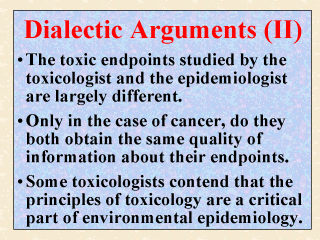 |
In addition to
the observations discussed in the last slide, Tomenson and Brown (1993) pointed out that
the toxic endpoints studied by the toxicologist and the epidemiologist could also serve to
illustrate some of the major differences between the two disciplines. They noticed that
whereas the epidemiologist has great difficulty in measuring the reproductive efficiency
of human couples, the toxicologist finds it difficult to measure neurobehavioral type
health responses in animals. Tomenson and Brown further concluded that "only in the
case of cancer is the epidemiologist likely to obtain the same quality of information
about the endpoint as is the toxicologist." Meanwhile, toxicology students would
agree that one of the most read toxicology references is Casarett and Doull's
Toxicology: The Basic Science of Poisons, of which recent revisions are edited by Dr.
Curtis D. Klaassen (Klaassen, 1996). Dr. Klaassen is currently the Editor-in-Chief of the
widely circulated journal Toxicological Sciences, and the head of the Toxicology
Section at the University of Kansas Medical Center. Simply put, Dr. Klaassen is one of the
preeminent authorities in toxicology. In another book's chapter entitled Environmental
Epidemiology for Chemists, Dr. Klaassen, together with Dr. Kershaw as the co-author
(1994), recapitulated much of the principles of toxicology that he presented earlier in
the Casarett and Doull reference. Words beginning with "epid" were never
mentioned beyond that chapter title. This finding may be interpreted as that the
principles of toxicology is fundamental to environmental epidemiologists. |
